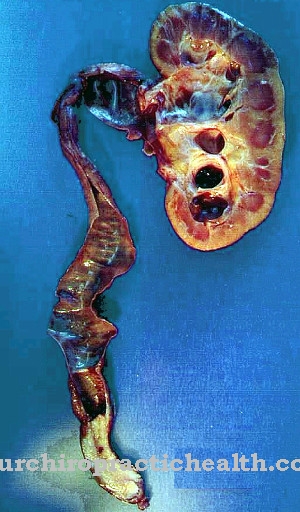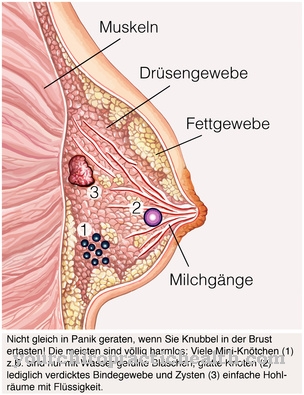Under a stroke, cerebral ischemiaor ischemic stroke is the most common type of stroke. It is based on ischemia - that is, a sudden reduction in blood flow to the brain - which can lead to the death of nerve and brain cells.
What is a cerebral infarction?

© blueringmedia - stock.adobe.com
The term cerebral infarction is mainly used when it is about one ischemic stroke acts. This results in a reduced blood flow to the brain, which leads to a reduced supply of glucose and oxygen to the organ.
In medicine, such a loss of blood flow is called ischemia. Obstructions or constrictions of the arteries supplying the brain are responsible for the reduced blood flow. If the ischemia is not reversible, it leads to the death of brain and nerve cells, which in turn triggers a cerebral infarction.
Cerebral infarction is classified as an urgent emergency by medicine. Ischemic stroke is one of the leading causes of death in industrialized countries. People older than 70 are particularly affected. A stroke is much more common in men than in women.
causes
In most cases, a cerebral infarction is caused by arteriosclerosis, also known as hardening of the arteries. In most people, this is caused by high blood pressure (hypertension), diabetes mellitus (diabetes) or the consumption of tobacco. The main reason for the occlusion of blood vessels is hardening of the arteries.
Over time, plaques accumulate on the inner walls of the blood vessels. This means deposits of fat and cells. The larger the size of the plaque, the more the affected blood vessel narrows.People who suffer from diabetes, high cholesterol or high blood pressure are particularly prone to the formation of plaques.
If an artery becomes increasingly narrowed by the plaques, sufficient oxygen-rich blood can no longer reach the tissue. There is also a risk of the plaque rupturing. This crack can lead to the formation of a thrombus (blood clot).
As a result, there is even a risk of complete closure of the vessel. This in turn leads to ischemia, in the course of which the supply of oxygen to the tissue is interrupted. The patient then suffers a stroke. Another possible cause of a cerebral infarction is an embolism. The resulting embolus can move freely and is able to follow the body's bloodstream.
In the worst case scenario, it blocks a blood vessel in the brain and causes a stroke. Inflamed cerebral vessels, malformations of the heart or cardiac arrhythmias are mostly responsible for an embolism. In addition to old age, the risk factors for a cerebral infarction include disorders of lipid metabolism, a lack of exercise, alcoholism and smoking.
Symptoms, ailments & signs
The abrupt appearance of various symptoms is typical of an ischemic stroke. The affected people suffer from a clouding of consciousness. This can manifest itself as tiredness, unconsciousness or a deep coma.
Other possible complaints are headache, vertigo, the perception of double vision, nausea, vomiting, swallowing and speech disorders, loss of the visual field, hemiplegia or paralyzed individual limbs and memory loss.
Neuropsychological deficits such as apraxia, attention deficit disorders and cognitive dysphasia also occur. Which symptoms are actually to be recorded depends on the affected vessel or brain area. Furthermore, there are various complaints in men and women.
Diagnosis & course of disease
If the patient shows early warning signs such as temporary abnormal sensations, brief symptoms of paralysis, speech disorders or memory problems, it is important to consult a doctor immediately. The doctor first deals in detail with the patient's medical history, which is followed by a neurological examination.
Diagnostic imaging methods such as computed tomography (CT) or magnetic resonance imaging (MRT) play an important role. By using them, one can quickly differentiate between a cerebral infarction and a cerebral hemorrhage, which is important for further treatment.
Possible examination methods also include angiography, Doppler sonography, an EEG to check the brain waves, an EKG to diagnose cardiac arrhythmias, and a lumbar puncture to check the cerebrospinal fluid (liquor). The course of a cerebral infarction depends on which brain region has been damaged and to what extent.
For a favorable prognosis, early therapy is extremely important. While some patients have mild effects, others require permanent care and are bedridden. It is not uncommon for chronic damage such as visual disturbances, language disorders or paralysis to be present. In the worst case, the patient dies from the stroke.
Complications
Even with rapid and proper treatment of a cerebral infarction, there is a risk of complications. These can make the consequences of the stroke worse. A dreaded complication is the increased intracranial pressure. It is triggered by accumulation of water or bleeding in the brain. There is also a risk of an epileptic seizure or thrombosis (blood clot) from the stroke.
When complications arise, it is of great importance where in the brain the cerebral infarction occurs. For example, a larger infarction in certain areas can sometimes only cause mild discomfort, while a smaller infarction in other brain regions results in very severe disabilities. In principle, however, serious consequences must be expected in the event of a cerebral infarction.
The course of the disease in the first few weeks after the stroke must also be taken into account. The typical sequelae of a cerebral infarction include permanent paralysis, problems swallowing, which are associated with a risk of aspiration, and pneumonia. Aspiration is when vomit, saliva, or food flows into the airways, which in turn causes pneumonia.
Numerous complications after a cerebral infarction arise from being bedridden afterwards. This includes, among other things, a pressure sore (pressure ulcer), which occurs together with sensitivity disorders. The restricted activity of the urinary bladder and kidneys threatens urinary tract infections. Improper positioning of the patient can also lead to joint stiffness.
When should you go to the doctor?
The cerebral infarction is a medical emergency. Without warning, the affected person loses control over various functional systems of the organism and is often no longer responsive. If you lose consciousness, intensive medical treatment must be given as soon as possible. Since the person concerned is threatened with sudden death, immediate action must be taken. Every minute before medical care is provided decides about the life of the person concerned and possible consequential damage.
An ambulance service is therefore required and first aid measures must be taken until it arrives. An emergency doctor should be contacted as soon as the first unexpected abnormalities occur. If the victim reports sudden malaise, weakness or double vision, there is cause for concern. A doctor is needed in the event of nausea, vomiting, dizziness or speech disorders. If there are concentration, orientation or attention disorders, emergency medical care must be provided. In the event of motor problems or symptoms of paralysis, the person affected needs immediate help.
In the event of memory loss, acute fatigue, unsteady gait or discomfort in one half of the body, a doctor's visit is necessary. If the person concerned falls into a comatose state, an emergency doctor should be called. If there are any signs of confusion, swallowing difficulties or deficiencies in the visual field, medical help is required as soon as possible. Observers of the event must ensure that the person concerned is ventilated.
Doctors & therapists in your area
Treatment & Therapy
Immediate treatment is required in the event of a cerebral infarction. This should take place in the hospital in a so-called stroke unit. There the sick person receives optimal diagnosis and therapy. He is also closely monitored. Body temperature, pulse, blood pressure, breathing and blood sugar are checked.
In addition, several medical disciplines such as neurology, neurosurgery, radiology and internal medicine work closely together. A possible treatment option for a cerebral infarction is lysis therapy, which is supposed to dissolve the blood clot.
Blood-thinning medication can also be given at an early stage of ischemic stroke. This primarily includes acetylsalicylic acid (ASA). However, this must not be taken during lysis therapy. Sufficient saturation of the blood with oxygen and thrombosis prophylaxis are also important.
Outlook & forecast
The time of first medical care and the location and size of the cerebral infarction are decisive for a prognosis. The later the person concerned receives intensive medical care and treatment, the worse the chances of recovery are in most cases. At the same time, the location of the damage in the human brain is relevant for a good prognosis. With very quick care and good subsequent rehabilitation, there are good prospects for recovery. Currently, however, every second patient with a cerebral infarction remains disabled, severely disabled or in need of care for life.
The extent of the damage to the brain must be assessed and classified individually. If areas of the brain tissue that regulate important functions of the organism, such as locomotion, thinking or speaking, are affected, impairments that have lifelong effects on the state of health are to be expected. Improvements in symptoms are possible, but recovery is unlikely.
In addition to the physical changes, a cerebral infarction often has sequelae. Due to the psychological strain caused by the changed living conditions, psychological complications can be expected. These usually worsen the healing process, lead to delays or can almost completely prevent recovery. With good mental strength and motivation in the patient, many physical improvements can be achieved. However, if paralysis does occur, it is permanent and irreparable.
prevention
So that a cerebral infarction does not occur in the first place, the risk factors for hardening of the arteries should be reduced. This includes regular monitoring of blood pressure and blood sugar as well as a lifestyle that includes a low-fat and low-sugar diet and sufficient exercise. In addition, the consumption of tobacco products should be avoided, because the risk of cerebral infarction increases significantly.
Aftercare
A cerebral infarction often results in speech and perception disorders or even paralysis. It is therefore important to start rehabilitation measures as early as possible during follow-up care. Recognizing and treating swallowing difficulties should be done as early as possible. Long-term damage can thus be minimized. Studies show that the first three months after a cerebral infarction are crucial for brain regeneration.
Unfortunately, it is part of the clinical picture that those affected can suffer further strokes after acute treatment for a cerebral infarction. Therefore, experts advise to seek inpatient rehab. The reduction in brain performance is difficult to diagnose in outpatient rehab. These can be various symptoms, such as a disturbance of perception, memory or short-term memory.
It is difficult to make a general statement about the correct follow-up care for a cerebral infarction. It requires an exact investigation of the cause in order to connect to it the optimal aftercare. However, it is precisely the control and reduction of risk factors that should be taken into account during follow-up care.
Smoking, obesity and a generally unhealthy lifestyle massively increase the risk of another cerebral infarction. Adequate exercise, a healthy diet and little alcohol and tobacco products can ensure that another cerebral infarction does not recur, even at an advanced age.
You can do that yourself
A cerebral infarction is also known as a stroke, where every minute counts to be recognized as such. If this is treated successfully as soon as possible, follow-up care will be inevitable. The longer the diagnosis is postponed, the more damage can be caused to the sick person. In the event of consequential damage caused by the disease, such as one-sided paralysis or language difficulties, the person affected must take professional rehabilitation measures. These should be carried out by a specialist in his practice. It takes a lot of patience and empathy to achieve effective recovery. With timely detection and treatment as well as the necessary therapy, it is possible in many cases that the patient is completely cured again.
In order to avoid a subsequent cerebral infarction, the patient will have to change his or her lifestyle, stop smoking and excessive alcohol consumption and, under certain circumstances, change the diet to a healthy diet. If another incident does occur, it is important to take immediate action. These are to be brought to the hospital immediately or to call the emergency service, who is told on the phone that a cerebral infarction has already preceded. The signs are one-sided obstruction of the movement, difficulty speaking, impaired vision, which can be recognized.



.jpg)





















.jpg)


